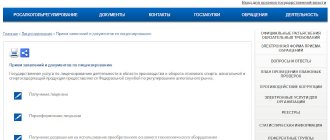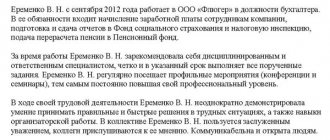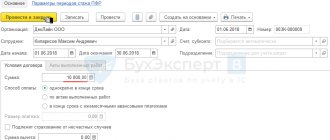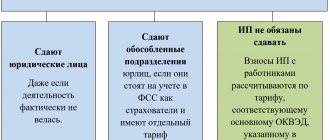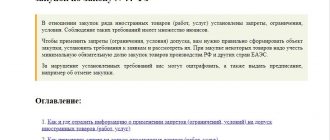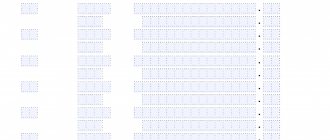Occupational risk assessment is a mandatory procedure that must be carried out in any organization, regardless of status, business scale and area of activity.
Since 2022, amendments have come into force affecting the Decree of the Government of the Russian Federation No. 806 and legislative acts for 2016, which were previously used to calculate the assessment of professional risks, identify possible hazards and report enterprises.
Supervisory authorities are now conducting inspections according to the new regulations. According to Art. 5.27.1 part 1 of the Code of Administrative Offenses and the established rules for inspecting organizations, they can fine for incorrect reporting and failure to assign a class of professional risks according to OKVED.
The amount of the established fine is from 50,000 to 80,000 rubles.
Verification and submission of reports is carried out annually. In addition, situation analyzes, risk calculations and determination of safety measures must be carried out when changing the technological process, modernization, or introducing new equipment or material.
Let us consider in detail the most current requirements related to this topic. Alexander Davydov, an expert of the PromProfAlliance group of companies on labor protection, answers user questions.
What classes, levels and categories of hazards exist?
Hazard identification is primarily carried out after identifying the causes that may cause the problem situation:
- Animals, insects, plants, microorganisms.
- Explosion, violence, collapse, improperly organized production process.
- Testing new material, equipment, product tasting.
- Microclimate, weather conditions, thermal parameters, chemical composition of air.
- Hard work, stress, stress.
- Radiation, waves, ionization, noise, light, vibration, mechanical stress and other physical factors.
- Relief, landscape, features of the area where workplaces are located.
- Aggressive poisons, chemicals, toxicity, etc.
After compiling a list of hazardous factors, the degree of likelihood that this will happen is determined. Assessing the level of professional risk by degree of probability involves several options and is assessed by points. The scores also assess the degree of exposure and possible consequences.
The calculation of the profrisk index is directly proportional to its level and the urgency of the necessary measures.
What professional risk class rates are set in 2020?
If the dangers are assessed and calculated, the enterprise is assigned a pro-free insurance class, according to which it must pay insurance premiums to the Social Insurance Fund. The code used is OKVED 2. For clarity, I will show the tariffs in the table.
Table of occupational risk classes and insurance premium rates for the Social Insurance Fund for 2022
| Occupational risk class | Tariff for insurance premium, % | Occupational risk class | Tariff for insurance premium, % |
| I | 0,2 | XVII | 2,1 |
| II | 0,3 | XVIII | 2,3 |
| III | 0,4 | XIX | 2,5 |
| IV | 0,5 | XX | 2,8 |
| V | 0,6 | XXI | 3,1 |
| VI | 0,7 | XXII | 3,4 |
| VII | 0,8 | XXIII | 3,7 |
| VIII | 0,9 | XXIV | 4,1 |
| IX | 1,0 | XXV | 4,5 |
| X | 1,1 | XXVI | 5,0 |
| XI | 1,2 | XXVII | 5,5 |
| XII | 1,3 | XXVIII | 6,1 |
| XIII | 1,4 | XXIX | 6,7 |
| XIV | 1,5 | XXX | 7,4 |
| XV | 1,7 | XXXI | 8,1 |
| XVI | 1,9 | XXXII | 8,5 |
How to determine the occupational risk class
According to the class of professional risk, types of economic activity are divided into 32 groups - from the lowest risk to the highest. The risk class is determined by the level of industrial injuries, illness and insurance costs.
Organizations must confirm their main type of activity by April 15 (individual entrepreneurs do not need to do this). To do this, they submit an application to the Social Insurance Fund, a certificate confirming the type of activity, and an explanatory note to the reporting for the previous year. Changing the OKVED code during the year will not lead to a change in the insurance rate. However, if the FSS revises the risk class for your type of activity, then you will have to pay contributions at the updated tariff.
Based on these documents, the FSS will assign you the appropriate risk class. If you do not submit documents on time, the FSS will select the type of your activity that has the highest risk and set the tariff rate for it. Always submit documents on time, because the Social Insurance Fund has every right to set the maximum tariff and this cannot be challenged.
If you work in one area , you can find out the risk group of your activity from Order of the Ministry of Labor No. 851n, which presents a table of risk classes according to OKVED.
If activities are carried out in different areas. Many entrepreneurs operate in various fields and fall under several risk classes at the same time. In this case, the risk class is determined by the main type of activity and the OKVED code specified during registration.
If it is not possible to determine the main type of activity . This can happen with an equal share of all activities in the total turnover or equal revenue from each of them. In this case, the type of activity that has the highest class of professional risk will be recognized as the main one.
Can an occupational safety specialist conduct an occupational risk assessment?
Until recently, SOT or other organizational specialists themselves tried to identify and analyze risks, and also found methods to minimize them. Previously, this process was not so seriously controlled by inspection authorities.
Many did not really know how occupational risks are assessed at an enterprise. The responsible employee was based on GOST R ISO 31000-2010 “Risk Management. Principles and guidance”, GOST R ISO/IEC 31010 - 2011 “Risk assessment methods”, Model provision No. 438n and other legislative acts.
However, due to amendments in 2022, these methods are completely de-legislated. There are new methods for assessing professional risks, according to which it is necessary to make calculations, draw up a report, and develop effective safety measures.
I advise you to contact a professional company. Our specialists will conduct an assessment, calculate indicators and prepare the necessary package of documents in 3 days. No errors from the point of view of the Letter of the Law and, accordingly, no fines or claims from the State Tax Inspectorate.
Assessment of professional risk levels by the employer
The requirements for conducting an assessment of professional risks are established by Article 212 of the Labor Code of the Russian Federation. Employees and candidates must be made aware of the risks associated with their position. If the risks are unacceptable from the point of view of applicants, they have the right to find another, safer place of work.
The employer is obliged to conduct a risk assessment at the enterprise:
- create a hazard register
- calculate the probability of an unfavorable outcome and damage to health
- draw up an action plan to reduce or eliminate risks.
Many occupational safety and health professionals may ask why carry out a risk assessment if a special assessment has already been carried out. Everything is very simple. During a special assessment, factors are identified, but the likelihood that the factor could lead to injury, acute or chronic illness, or death is not assessed. If, when applying for a job, a person learns that his workplace has a high degree of risk, he has a choice - to accept this risk, or to look for another place of work.
One of the most important tasks of the employer at the stage of transition to the new legislative framework on labor protection is to review and apply the results of the risk assessment that has already been carried out. For new organizations and individual entrepreneurs, it is urgent to organize an assessment of professional risks.
In accordance with paragraphs 7, 21-23 of Article 212 of the Labor Code of the Russian Federation and in connection with the entry into force of new labor protection rules on January 1, 2021, occupational safety specialists must:
- organize extraordinary types of training on labor protection (briefings, extraordinary testing of knowledge of new rules)
- carry out the initial assignment of groups of work at height for workers with a high risk of falling from scaffolding (in training centers with training grounds)
- update a set of regulatory legal acts containing labor protection requirements in accordance with the specifics of its activities
- update a set of local regulations of the employer, including instructions on labor protection, training programs on labor protection for workers, information materials used to inform employees about labor conditions and safety in the workplace, about the risk of damage to health in the scope of those new safety rules labor, which regulate the labor activities of workers
Methods for assessing professional risks
To assess professional risks, any methodology specified in GOST, international standards, as well as proprietary methods of Russian and foreign specialists in technosphere risks are used.
The employer has the right to use any method at his own discretion , depending on the characteristics of his economic activity and the complexity of production processes; he can develop a methodology independently, if he has such an opportunity.
An example of methods that a company can use to evaluate profit margins:
➤ National standard of the Russian Federation GOST R ISO/IEC 31010–2011
Officially, it was in effect until March 1, 2022 and described 31 methods for identifying and assessing profit risks. The cancellation of this document is not a reason not to apply the current methods specified in it, nor is it a reason to draw useful recommendations from this document.
Expert advice: GOST is a document for voluntary use. It would be incorrect to indicate the canceled GOST in the “Risk Assessment Procedure” section of the OHS Regulations, so look at the methods in it that are relevant for your organization and are valid.
➤ GOST R 12.0.010-2009 “System of occupational safety standards (OSSS). Occupational safety management systems. Hazard identification and risk assessment.”
This state standard determines the procedure for assessing risks, regardless of the chosen methodology. There are many methods for conducting risk assessment, but the principle of assessment is the same: the input is objective information about actual working conditions, and the output is an emergency action plan to eliminate risks (refusal of hazardous work) or to minimize them (compensatory measures). This GOST is also a voluntary document until it is enshrined in a local regulatory act.
Expert advice: we recommend transferring the development of the section on conducting risk assessments to the organization that will conduct your risk assessment. If you conduct a risk assessment yourself, be guided by this GOST and choose a technique that will solve your problems.
The main conditions that the employer must comply with when assessing the levels of occupational risks:
- take into account the current, past and future activities of the company;
- take into account that the severity of possible damage increases in proportion to the increase in the number of people exposed to danger;
- carry out risk assessments with the active participation of workers employed in these workplaces, since they have detailed and accurate information about all the hazards associated with their work;
- take into account not only normal operating conditions, but also cases of deviations in work, including those associated with possible accidents.
What professional risk assessment methods do you use?
Verification analysis and other actions are carried out in several stages. Measurements, calculations using formulas, making lists, classification, etc. are used. Work with typical low-risk companies is carried out remotely.
We will need a report on the labor safety standards, staffing schedule, documentation from the field of labor protection and other documents. Our experts go to OPOs with a high level of professional risk for assessment on the day the application is submitted. I'll tell you about the methods step by step.
- The head of the enterprise, by order, creates a commission of those responsible for labor protection, fire or electrical safety, heads of workshops and departments. This is necessary in order to familiarize our experts with the nuances of production. Who else but them should know the whole “kitchen” from the inside. Joint preliminary work will reduce the time required for the assessment.
- The situation in the workplace is being investigated. A map of occupational risks is drawn up at each workplace. For this purpose, as a rule, the outputs of the SOUT are used.
- Based on the information received and various types of available documents (reports, orders, instructions, journals, etc.), our experts identify and classify potential hazards. Lists of hazardous factors are compiled by level, degree and class.
- The data is analyzed, the assessment of occupational risks at the enterprise is calculated using the Fine-Kinney method, other algorithms and formulas.
- In accordance with the results obtained, safety measures are identified that need to be taken in order to minimize the level of risks, for example, use other personal protective equipment, protective equipment, carry out the prevention of occupational diseases, make adjustments to the operation of equipment, change the work schedule, etc.
- A package of necessary documents is collected, which includes a classification of potential hazards, workplace risk maps, a list of problems, measures to solve them, and other documentation required today.
Assessing the professional risks of workers and the enterprise itself is an important process for every organization. It will help to avoid unnecessary expenses, preserve the health and lives of workers, and report to the inspection authorities. The main thing is to correctly carry out, draw up and formalize this procedure and the papers associated with its implementation.


